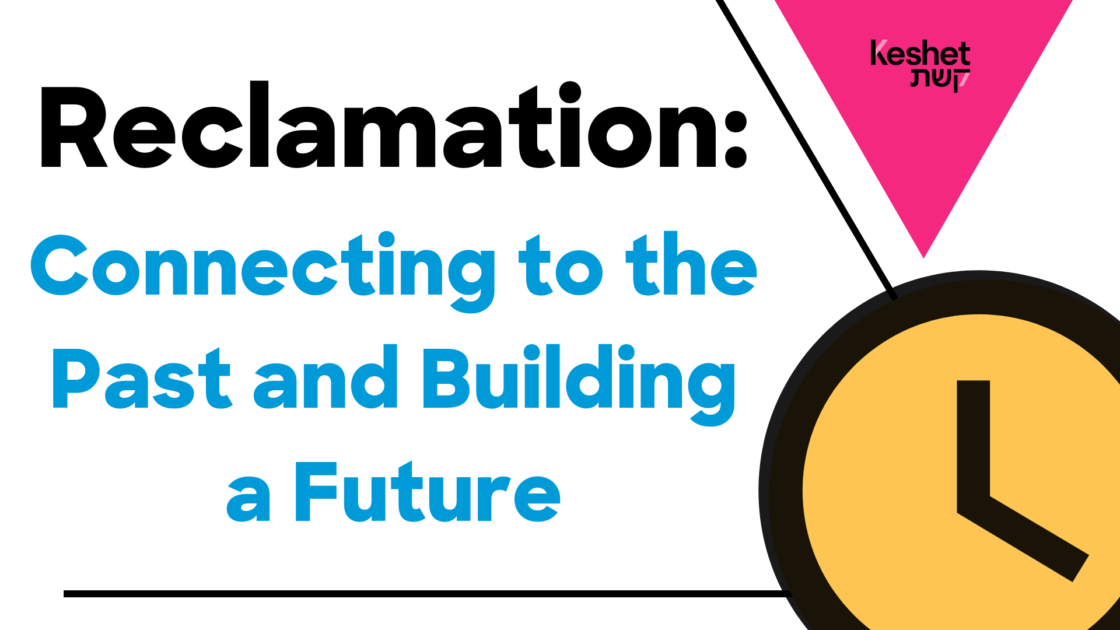
As we move into the last Parshah in the book of Numbers, we see Zelophehad’s five daughters stand up for themselves. They marshal their courage and stand before their leaders to plead for their father’s landholding. In some contemporary commentary this is considered one of the first signs of feminism in the Torah. Whether this is true or not, the distinctive theme of the story remains; bravery, coming out and self-advocacy, which I see as actions taken on by feminists and Queer Jews, especially those involved in founding Keshet. This week’s Torah portion reminds me of what my generation has gained from their pioneering efforts.
As I am thinking about my position at Keshet this summer, I am also looking back to Keshet’s origins and the commitment that was inscribed in the founding of the organization. This commitment was, and still is, grounded in a profound desire to be seen and heard as Queer Jews. The duality of Keshet’s mission– of both including Queer folk in Jewish spaces and creating new spaces for which all Jews have the ability to Queer Judaism itself– is a powerful task.
“Queer” is many things, and encapsulates a multitude of meanings for different individuals and communities. Queer is an umbrella term for those who do not fit into existing labels. Queer is a constant, integral home. Queer is a state of eccentricity and aberration. Queer is a reclamation of historical trauma. Queering is a verb or an action; often associated with puzzling, foiling, and destabilizing normative thinking and binary ways of being in the world. Queerness is a form of agency in the way that we negotiate received social codes. Queerness, above all else, is a process of unearthing, and is deeply invested in naming the “other.”
Keshet embodies these definitions of Queerness in its work to deconstruct heteronormative structures within organized religion, while still keeping the vibrant and spiritual integrity of Judaism and its powerful energy of community alive.
As Keshet’s advocacy intern, the project I have been a part of this summer involves community and institutional mobilization; work that necessitates building a network to ultimately educate and pass legislation that benefits Trans and Queer folk who are unprotected under the current legislation or the lack thereof. This means thinking about ways in which the “otherness” of being Queer needs to be protected in a world that often discriminates based on these differences. It means both understanding the desire to be treated no differently than anyone else, while also distinctively embracing Queerness, that celebrates the eccentricity and unearthing that it embodies.
In many ways, Queerness exposes the temporality of our world by denouncing linear structures and normative expectations that insist that the continuity of life and the possibility of futurity requires heterosexuality and reproduction. Keshet emphasizes, through its work of inclusion, that Queer identities are recognized as valid in the Jewish world, and that one does not need traditional or normative frameworks by which to live and love.
Time also teaches me another lesson, about the privileges I have coming into a space that was built for me, and the advantages that Queer Jews did not have twenty years ago. A space that goes beyond acceptance and accommodation and uses Queerness as a lens from which to build connection and change.
In this political climate, activism is brave work, and just like Zelophehad’s five daughters stood up for themselves, Keshet’s mission to stand up for Queer Jews is reflected in my experience as a young Jewish Queer woman who is able to participate in advocacy for others, like those before me who have led the way.

